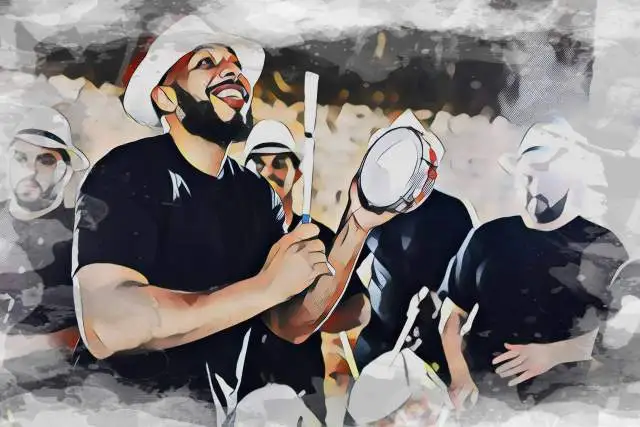Imagine strolling through the streets of Bogotá, dancing in a Mexico City club, or grabbing late-night tacos in Buenos Aires, and you hear a hypnotic rhythm filling the air. It's most likely cumbia, and it's absolutely everywhere.
Despite being one of Latin America's most widespread musical genres, cumbia remains something of a mystery to many music lovers outside the region. The legendary Gustavo Cordera from La Bersuit Vergarabat hit the nail on the head when he once said, "Latin rock feels jealous of cumbia music." And honestly? He wasn't wrong.
I'll never forget my first encounter with cumbia. I was a fresh-faced, 21-year-old on a night out in Downtown LA when I stumbled up La Cita Bar on Cumbia Night. Thinking I knew everything about music from my steady diet of Zeppelin, Marley, Wu-Tang Clan, and The Clash, since I was young, I wasn't ready for the experience that would change my taste in music forever. Then those infectious rhythms hit me like a ton of bricks.
Now, you may have had a similar experience, and are now sitting here thinking, "What in the world did I just hear for the first time and how do I hear more?"
Well, you made it to the right place, as this guide is meant to take you on a journey through the fascinating world of cumbia, from its humble beginnings to its current status as a cultural phenomenon that refuses to be boxed in.
Where Did Cumbia Music Originate?
Cumbia's origins trace back to Colombia's Caribbean coast in the late 19th century, where it emerged as a remarkable synthesis of multiple cultural influences. The genre developed through the convergence of African rhythmic patterns, brought by African slaves, with indigenous Colombian musical traditions and European influences.
This unique fusion was particularly evident in the traditional instruments that formed cumbia's foundation, including:
- The gaita : a native Colombian flute that usually carried the melody
- The guacharaca : A ribbed wooden stick that's scraped to create a distinctive scratching sound
- The llamador: A small hand drum that keeps the rhythm.
Even with many iterations throughout the years, the defining characteristics of cumbia music still lean on its distinctive double-beat pattern . This rhythmic structure has remained constant throughout the genre's evolution, serving as a through-line that connects modern interpretations back to their historical roots.
It's the true heartbeat of cumbia.
The 1970s brought a fascinating chapter in cumbia's development with the rise of psychedelic cumbia in Peru and Argentina. This unique variation emerged in remote Amazonian towns where oil drilling operations brought together workers from various backgrounds. These communities created a distinctive sound by combining traditional cumbia rhythms with sounds from psychedelic rock, such as electric guitars, layered organs, and more experimental arrangements.
As cumbia spread across Latin America, it spawned several regional variations.
Cumbia norteña incorporated the accordion and quickened the tempo, creating a more energetic style, while cumbia andina featured traditional Andean wind instruments, adding a distinctive mountain music flavor to the basic cumbia framework.
The traditional cumbia dance is said to have movements that mirror the courtship dances performed by African enslaved people along Colombia's northern coast. Partners would maintain a decent amount of space between them while moving in synchronized patterns.
A few decades prior, there was another crucial moment in cumbia's history, when during the 1940s, the genre reached Monterrey, Mexico. Luis Carlos Meyer made history as the first artist to record a cumbia song outside of Colombia, opening the door for future artists throughout Latin America. Following in his footsteps, artists like Rafael de Paz and Tony Camargo further developed the genre, each contributing their own stylistic elements to cumbia's evolving sound.
Before long, cumbia was pumping through Mexico City's Tepito and Santa Martha Acatitla neighborhoods. By the 1980s, massive sound systems (sonidos) were setting up shop in the streets, blasting cumbia for entire neighborhoods. You could cumbia in just about everything from house parties to neighborhood-wide cultural celebrations, which helped cement its place in urban culture.
Modern Cumbia Music
Today, you can still hear cumbia pulsing through every corner of Mexico, from upscale nightclubs in Mexico City to family parties in tiny villages. It's the soundtrack to both quinceañeras and underground raves, which really shows just how adaptable this genre can be.
Modern DJs, otherwise known as sonideras, have taken cumbia to wild new places by mixing classic rhythms with electronic music, hip-hop breaks, and reggae basslines. Even with all these modern twists, you can still catch the unmistakable sound of the genre's traditional instruments.
I highly recommend checking out Sonido Gallo Negro from Mexico City. This nine-piece band is bringing back the psychedelic spirit of 1970s tropical music with a modern twist.
Nicola Cruz is another interesting musician modernizing the sounds of early Latin America. This Ecuadorian producer blends traditional cumbia rhythms with deep electronic textures and Andean folk music, dubbing his sound "Andes Step."
What Are the Components of Cumbia Music?
Cumbia’s rhythm-heavy nature is no accident, as it all started on the Colombian Caribbean coast.
While we can’t time-travel to see the original cumbia setups, historians and musicians have pieced together a pretty solid idea of what traditional ensembles looked like:
- Llamador : A small hand drum that sets the tempo and calls the group together.
- Tambora : This double-headed drum is struck with sticks and acts kind of like a modern kick.
- Tambor Alegre : A cheerful drum (literally) that adds melodic flourishes to the mix.
- Maracas : You've most likely heard of these shaken percussion instruments, which are often either wood or plastic-shaped gourds or turtle shells filled with seeds or beans.
- Flutes : Typically made from cane, these bring a wistful, melodic counterbalance to the percussion.
- Guache : A metal cylinder filled with seeds, shaken for a distinct rasping sound.
- Vocals : Often performed in call-and-response style, though vocals can come in all forms. Depending on the region, lyrics are typically either sung in Spanish or African languages.
If we look at the components of cumbia today, considering the fact that it's gone global, the instrumentation has expanded far beyond its roots. You'll find everything from guitars and pianos to electric basses, accordions, and brass.
This is because the genre is now reflecting influences from genres like salsa, rock, and electronic music.
One of the most fascinating cumbia legends involves the accordion. According to local lore, a German cargo ship wrecked in the Magdalena River , scattering accordions onto the beach. The locals salvaged these instruments and, in true creative fashion, wove their distinctive sound into cumbia.
The Rhythm of Cumbia
At the heart of cumbia lies its unmistakable rhythm. Traditionally, cumbia is built on a 2/4 duple rhythm , a simple yet infectious pattern that’s easy to recognize. It’s a really primal-feeling beat that almost feels like it's part of our collective DNA.
The fun part is that cumbia rhythms are not a one-size-fits-all deal. Different countries have put their unique spin on the beat:
- Colombia : The birthplace of cumbia sticks mostly to 2/4 and occasionally 2/2 , staying close to its roots with that signature lilt.
- Mexico : Mexican cumbia often leans into 2/2 .
- Panama : Panama throws some curveballs with 2/4 , 4/4 , and even 6/8 , creating variations that reflect the country’s rich musical diversity.
One of the more modern influences on cumbia’s rhythm is Latin jazz , particularly the energetic improvisation of Latin Alegre . This style encourages freedom within the framework of cumbia’s beat, letting musicians riff and experiment while keeping the groove intact.
There's also cumbia rebajada , which originates from northern Mexico. This style takes the tempo down a notch to give the music a more hypnotic, laid-back vibe.
The evolution of cumbia music has given us a number of unique hybrid genres, including cumbia ska, cumbia dub, and cumbia reggaetón.
The Most Iconic Cumbia Bands and Groups
With cumbia being such a huge part of Latin American culture, there’s no shortage of amazing bands that have left their mark on the genre. That said, any list of iconic cumbia music groups is bound to spark debates among die-hard fans.
While I can’t claim this lineup will satisfy every aficionado, these are a few of my personal favorites to get you started:
Son Palenque
This seven-piece group, which got its start in the city of Cartagena during the 1980s, is a celebration of Afro-Colombian roots. They became renowned for honoring the sounds of Palenque de San Basilio, which is a town that was founded by black Maroons in 1706 and now has a deep African cultural heritage.
Los Ángeles Azules
If you’ve ever been to a Latin party, chances are you’ve danced to a song from Los Ángeles Azules. Hailing from Mexico, this group has pretty much become the global ambassador for cumbia. Their signature style, which combines traditional cumbia with romantic lyrics and pop arrangements - has given us hits like "Cómo Te Voy a Olvidar” and "El Listón de Tu Pelo." They’ve also collaborated with many big contemporary artists, making their sound timeless.
La Sonora Dinamita
When it comes to cumbia royalty, La Sonora Dinamita reigns supreme. Originally formed in Colombia, they’ve become an institution in cumbia music. Known for their sultry, brass-heavy sound and playful lyrics, tracks like "Mi Cucu" and "Oye" are staples in any cumbia playlist. Their music has crossed generations throughout Latin America and borders throughout the world.
Meridian Brothers
If you're looking for a more modern and experimental take on cumbia, this Colombian group is the one to check out. Led by Eblis Álvarez, the group's music is a psychedelic, offbeat twist on traditional cumbia, infused with synths, samples, and a quirky sense of humor.
Pedro ‘Ramayá’ Beltrán
Known as the king of the caña de millo (a traditional reed flute), Pedro ‘Ramayá’ Beltrán is a living legend of Colombian cumbia. His mastery of this indigenous instrument and his ability to merge it seamlessly with Afro-Colombian rhythms have earned him a place in the pantheon of cumbia greats.
A Taste of Latin America
From reggaetón to salsa, and tango to bossa nova, Latin music spans far and wide. However, there is nothing that heavily influenced so many popular artists throughout the world quite like cumbia. The genre is the musical backbone of Latin America, as it includes elements of so many other great genres from Argentina, Peru, Costa Rica, Africa, and more!
There's not just one single way to listen, dance to, or play cumbia, and I highly recommend exploring this musical style as deeply as you can, as it has endless joy to offer.





